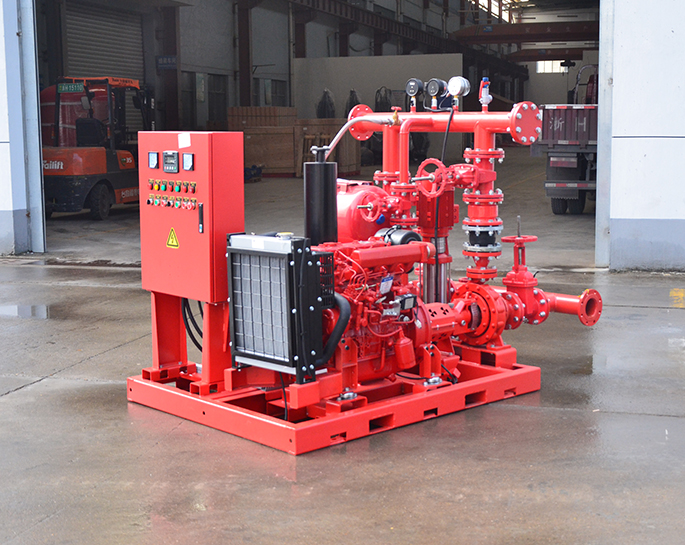What factors should be considered when selecting a firefighting pump?
Feb 18, 2024
Share:
Selecting a firefighting pump involves considering several critical factors to ensure it meets the specific needs of the firefighting operation. Here are some key considerations:
1. **Flow Rate and Pressure**: Determine the required flow rate and pressure based on the size and nature of potential fires. Consider factors such as building size, fire intensity, and distance to water sources.
2. **Pump Type**: Choose between centrifugal pumps and positive displacement pumps based on factors such as required flow rate, pressure, and intended application. Centrifugal pumps are more common for firefighting due to their higher flow rates, while positive displacement pumps provide higher pressure.
3. **Power Source**: Decide on the appropriate power source for the pump, such as gasoline, diesel, electric, or hydraulic. Consider factors like availability, reliability, and ease of refueling.
4. **Portability and Mobility**: Consider whether the pump needs to be portable or mounted on a vehicle. Portable pumps are versatile but may have lower flow rates, while vehicle-mounted pumps offer higher flow rates but may have limitations in accessing certain areas.
5. **Durability and Reliability**: Choose a pump that is rugged, durable, and reliable, capable of withstanding harsh firefighting conditions. Look for pumps made from corrosion-resistant materials and with a proven track record of reliability.
6. **Maintenance Requirements**: Assess the maintenance needs of the pump, including routine inspections, servicing, and repairs. Choose a pump that is easy to maintain and has readily available spare parts.
7. **Compatibility with Accessories**: Ensure compatibility with firefighting accessories such as hoses, nozzles, and foam systems. The pump should be able to accommodate the necessary accessories for effective firefighting operations.
8. **Safety Features**: Look for safety features such as low oil shutdown, thermal protection, and spark arrestors to minimize the risk of accidents and equipment damage during operation.
9. **Cost and Budget**: Consider the initial purchase cost as well as long-term operating and maintenance costs. Balance the budget constraints with the need for quality and reliability.
10. **Regulatory Compliance**: Ensure that the selected pump meets relevant regulatory standards and requirements for firefighting equipment, including certifications and approvals from relevant authorities.
By carefully considering these factors, you can select a firefighting pump that meets the specific requirements of your firefighting operation and helps effectively combat fires while ensuring the safety of personnel and property.

1. **Flow Rate and Pressure**: Determine the required flow rate and pressure based on the size and nature of potential fires. Consider factors such as building size, fire intensity, and distance to water sources.
2. **Pump Type**: Choose between centrifugal pumps and positive displacement pumps based on factors such as required flow rate, pressure, and intended application. Centrifugal pumps are more common for firefighting due to their higher flow rates, while positive displacement pumps provide higher pressure.
3. **Power Source**: Decide on the appropriate power source for the pump, such as gasoline, diesel, electric, or hydraulic. Consider factors like availability, reliability, and ease of refueling.
4. **Portability and Mobility**: Consider whether the pump needs to be portable or mounted on a vehicle. Portable pumps are versatile but may have lower flow rates, while vehicle-mounted pumps offer higher flow rates but may have limitations in accessing certain areas.
5. **Durability and Reliability**: Choose a pump that is rugged, durable, and reliable, capable of withstanding harsh firefighting conditions. Look for pumps made from corrosion-resistant materials and with a proven track record of reliability.
6. **Maintenance Requirements**: Assess the maintenance needs of the pump, including routine inspections, servicing, and repairs. Choose a pump that is easy to maintain and has readily available spare parts.
7. **Compatibility with Accessories**: Ensure compatibility with firefighting accessories such as hoses, nozzles, and foam systems. The pump should be able to accommodate the necessary accessories for effective firefighting operations.
8. **Safety Features**: Look for safety features such as low oil shutdown, thermal protection, and spark arrestors to minimize the risk of accidents and equipment damage during operation.
9. **Cost and Budget**: Consider the initial purchase cost as well as long-term operating and maintenance costs. Balance the budget constraints with the need for quality and reliability.
10. **Regulatory Compliance**: Ensure that the selected pump meets relevant regulatory standards and requirements for firefighting equipment, including certifications and approvals from relevant authorities.
By carefully considering these factors, you can select a firefighting pump that meets the specific requirements of your firefighting operation and helps effectively combat fires while ensuring the safety of personnel and property.







